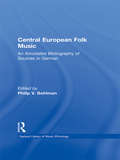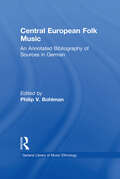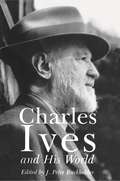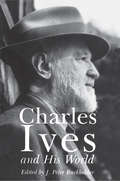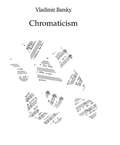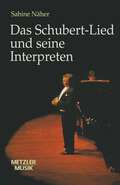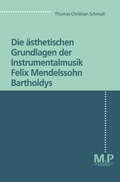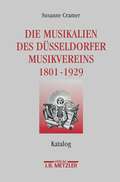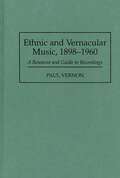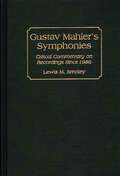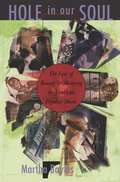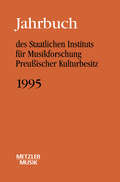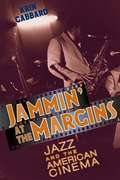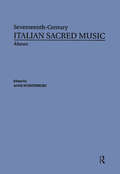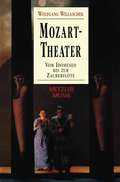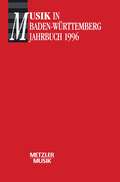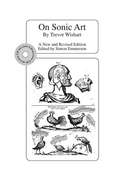- Table View
- List View
Carmen: As Produced At The Manhattan Opera House Under The Direction Of Oscar Hammerstein (classic Reprint) (Oberon Modern Plays)
by Georges BizetThe Olivier Award nominated producers of La Traviata, La bohème and Tosca present a vivid, compelling and devastatingly powerful take on Georges Bizet’s masterpiece. Carmen works minimum wage jobs on the frontline of Britain’s crumbling service industry. Jose falls madly in love with her after a brief fling. As his passion morphs into something uglier, and far more troubling, Carmen realises she might have made a fatal mistake… Sung in English, and blending stark emotional realism with some of the world’s most beloved music, this highly original new production examines toxic relationships in a society on the brink of collapse.
Central European Folk Music: An Annotated Bibliography of Sources in German (Routledge Music Bibliographies)
by Philip V. BohlmanFirst Published in 1996. Routledge is an imprint of Taylor & Francis, an informa company.
Central European Folk Music: An Annotated Bibliography of Sources in German (Routledge Music Bibliographies #Vol. 3)
by Philip V. BohlmanFirst Published in 1996. Routledge is an imprint of Taylor & Francis, an informa company.
Charles Ives and His World: Charles Ives And The Uses Of Musical Borrowing (The Bard Music Festival #51)
by J. BurkholderThis volume shows Charles Ives in the context of his world in a number of revealing ways. Five new essays examine Ives's relationships to European music and to American music, politics, business, and landscape. J. Peter Burkholder shows Ives as a composer well versed in four distinctive musical traditions who blended them in his mature music. Leon Botstein explores the paradox of how, in the works of Ives and Mahler, musical modernism emerges from profoundly antimodern sensibilities. David Michael Hertz reveals unsuspected parallels between one of Ives's most famous pieces, the Concord Piano Sonata, and the piano sonatas of Liszt and Scriabin. Michael Broyles sheds new light on Ives's political orientation and on his career in the insurance business, and Mark Tucker shows the importance for Ives of his vacations in the Adirondacks and the representation of that landscape in his music. The remainder of the book presents documents that illuminate Ives's personal life. A selection of some sixty letters to and from Ives and his family, edited and annotated by Tom C. Owens, is the first substantial collection of Ives correspondence to be published. Two sections of reviews and longer profiles published during his lifetime highlight the important stages in the reception of Ives's music, from his early works through the premieres of his most important compositions to his elevation as an almost mythic figure with a reputation among some critics as America's greatest composer.
Charles Ives and His World (The Bard Music Festival: 7) (PDF)
by J. BurkholderThis volume shows Charles Ives in the context of his world in a number of revealing ways. Five new essays examine Ives's relationships to European music and to American music, politics, business, and landscape. J. Peter Burkholder shows Ives as a composer well versed in four distinctive musical traditions who blended them in his mature music. Leon Botstein explores the paradox of how, in the works of Ives and Mahler, musical modernism emerges from profoundly antimodern sensibilities. David Michael Hertz reveals unsuspected parallels between one of Ives's most famous pieces, the Concord Piano Sonata, and the piano sonatas of Liszt and Scriabin. Michael Broyles sheds new light on Ives's political orientation and on his career in the insurance business, and Mark Tucker shows the importance for Ives of his vacations in the Adirondacks and the representation of that landscape in his music. The remainder of the book presents documents that illuminate Ives's personal life. A selection of some sixty letters to and from Ives and his family, edited and annotated by Tom C. Owens, is the first substantial collection of Ives correspondence to be published. Two sections of reviews and longer profiles published during his lifetime highlight the important stages in the reception of Ives's music, from his early works through the premieres of his most important compositions to his elevation as an almost mythic figure with a reputation among some critics as America's greatest composer.
Chromaticism
by Vladimir BarskyFirst Published in 1996. Routledge is an imprint of Taylor & Francis, an informa company.
Chromaticism (PDF)
by Vladimir BarskyFirst Published in 1996. Routledge is an imprint of Taylor & Francis, an informa company.
Die ästhetischen Grundlagen der Instrumentalmusik Felix Mendelssohn Bartholdys: M&P Schriftenreihe
by Thomas Christian SchmidtDisposition und Ausarbeitung in Bachs späten Clavier-Werken (1739-1749): M&P Schriftenreihe
by Stefan OrgassEthnic and Vernacular Music, 1898-1960: A Resource and Guide to Recordings (Discographies: Association for Recorded Sound Collections Discographic Reference)
by Paul VernonDetailed information on almost all ethnic and vernacular recordings from many countries on 78rpm is provided in this seminal work. The current state of discographical research in this wide and varied field is such that a research tool of this nature is badly needed. Jesse Walter Fewkes and Mary Hemenway recorded Native American music as early as 1890; Bela Bartok recorded rural music in the Balkans; Erich von Hornbostel, the grand old man of ethnomusicology in Europe, recorded in Southeast Asia. More than just a discography, this work demonstrates that cultures around the world and over time have more similarities than differences. A necessity for scholars, students, archivists, and individual record collectors and dealers.The goals of this volume are many and varied: to promote thought and discussion toward a concise definition of recorded ethnic music; to assist specialists working on individual discographical projects; to introduce users to the interconnectedness of cultures through regional music; to gather heretofore disparate pieces of information under one cover in a way that for the first time allows specialists to accurately identify all manner of recordings in many languages. The four sections of the volume work together for easy usage through cross referencing. The philosophy behind the volume was expressed by Rodney Gallop when he remarked that music, for him, was often the key to the understanding of other cultures.
Gustav Mahler's Symphonies: Critical Commentary on Recordings Since 1986 (Discographies: Association for Recorded Sound Collections Discographic Reference)
by Lewis M. SmoleyThe popularity of Mahler's symphonic works is unremitting. More recordings have been made during the past ten years than in the previous six decades. This work is a companion to the first volume, published in 1986; together, the two review virtually every recording commercially released (as well as some private issues). The intention of both works is to provide a comprehensive analysis of all recordings. A general overview is combined with details of particular importance. Recordings of special merit are noted. The objective critical discussions will appeal to the newcomer as well as the knowledgeable devotee and the work will serve as a valuable addition to university, music school, and public libraries, as well as any music lover's library.This guide provides a symphony-by-symphony commentary, including the unfinished Tenth Symphony, Das Lied von der Erde, and piano and chamber music reductions of the works. It includes all new recordings issued worldwide as well as compact disc reissues of previously released recordings and all performances on videocassette. Listings are arranged alphabetically by conductor, and headings for each recording contain specific information about the performers, record label, catalog number, and timing. Helpful indexes by conductor, orchestra, vocal and instrumental soloists, chorus, and record label are included.
Handbook of Recording Engineering
by John M. EargleJohn Eargle's 4th edition of The Handbook of Recording Engineering is the latest version of his long-time classic hands-on book for aspiring recording engineers. It follows the broad outline of its predecessors, but has been completely recast for the benefit of today's training in recording and its allied arts and sciences. Digital recording and signal processing are covered in detail, as are actual studio miking and production techniques -- including the developing field of surround sound. As always, the traditional topics of basic stereo, studio acoustics, analog tape recording, and the stereo LP are covered in greater detail than you are likely to find anywhere except in archival references.This book has been completely updated with numerous new topics added and outdated material removed. Many technical descriptions are now presented in Sidebars, leaving the primary text for more general descriptions.Handbook of Recording Engineering, Fourth Edition is for students preparing for careers in audio, recording, broadcast, and motion picture sound work. It will also be useful as a handbook for professionals already in the audio workplace.
Hole in Our Soul: The Loss of Beauty and Meaning in American Popular Music
by Martha BaylesFrom Queen Latifa to Count Basie, Madonna to Monk, Hole in Our Soul: The Loss of Beauty and Meaning in American Popular Music traces popular music back to its roots in jazz, blues, country, and gospel through the rise in rock 'n' roll and the emergence of heavy metal, punk, and rap. Yet despite the vigor and balance of these musical origins, Martha Bayles argues, something has gone seriously wrong, both with the sound of popular music and the sensibility it expresses. Bayles defends the tough, affirmative spirit of Afro-American music against the strain of artistic modernism she calls 'perverse.' She describes how perverse modernism was grafted onto popular music in the late 1960s, and argues that the result has been a cult of brutality and obscenity that is profoundly anti-musical. Unlike other recent critics of popular music, Bayles does not blame the problem on commerce. She argues that culture shapes the market and not the other way around. Finding censorship of popular music "both a practical and a constitutional impossibility," Bayles insists that "an informed shift in public tastes may be our only hope of reversing the current malignant mood."
Jammin' at the Margins: Jazz and the American Cinema (Phoenix Fiction Ser.)
by Krin GabbardAmerican cinema has long been fascinated by jazz and jazz musicians. Yet most jazz films aren't really about jazz. Rather, as Krin Gabbard shows, they create images of racial and sexual identity, many of which have become inseparable from popular notions of the music itself. In Jammin' at the Margins, Gabbard scrutinizes these films, exploring the fundamental obsessions that American culture has brought to jazz in the cinema. Gabbard's close look at jazz film biographies, from The Jazz Singer to Bird, reveals Hollywood's reluctance to acknowledge black subjectivity. Black and even white jazz artists have become vehicles for familiar Hollywood conceptions of race, gender, and sexuality. Even Scorsese's New York, New York and Spike Lee's Mo' Better Blues have failed to disentangle themselves from entrenched stereotypes and conventions. Gabbard also examines Hollywood's confrontation with jazz as an elite art form, and the role of the jazz trumpet as a crucial signifier of masculinity. Finally, he considers the acting careers of Louis Armstrong, Nat King Cole, and Hoagy Carmichael; Duke Ellington's extraordinary work in films from 1929 until the late 1960s; and the forgotten career of Kay Kyser, star of nine Hollywood films and leader of a popular swing band. This insightful look at the marriage of jazz and film is a major contribution to film, jazz, and cultural studies.
The Life, Death, and Afterlife of the Record Store: A Global History
by Gina Arnold, John Dougan, Christine Feldman-Barrett, and Matthew WorleyOnce conduits to new music, frequently bypassing the corporate music industry in ways now done more easily via the Internet, record stores championed the most local of economic enterprises, allowing social mobility to well up from them in unexpected ways. Record stores speak volumes about our relationship to shopping, capitalism, and art. This book takes a comprehensive look at what individual record stores meant to individual people, but also what they meant to communities, to musical genres, and to society in general. What was their role in shaping social practices, aesthetic tastes, and even, loosely put, ideologies? From women-owned and independent record stores, to Reggae record shops in London, to Rough Trade in Paris, this book takes on a global and interdisciplinary approach to evaluating record stores. It collects stories and memories, and facts about a variety of local stores that not only re-centers the record store as a marketplace of ideas, but also explore and celebrate a neglected personal history of many lives.
Masses by Giovanni Rovetta, Ortensio Polidori, Giovanni Battista Chinelli, Orazio Tarditi (Seventeenth Century Italian Sacred Music in Twenty Five)
by Anne SchnoebelenThe purpose of this series is to provide a large repertory 17th century Italian sacred music in clear modern editions that are both practical and faithful to the original sources.
Masses by Giovanni Rovetta, Ortensio Polidori, Giovanni Battista Chinelli, Orazio Tarditi (Seventeenth Century Italian Sacred Music in Twenty Five)
by Anne SchnoebelenThe purpose of this series is to provide a large repertory 17th century Italian sacred music in clear modern editions that are both practical and faithful to the original sources.
Musik in Baden Würtemberg, Band 1: Jahrbuch 1996
by Georg Günther"Musik in Baden-Württemberg" versteht sich als Forum der regionalen Musikgeschichtsschreibung des deutschen Südwestens. Die Jahrbücher können zur Fortsetzung bezogen werden.
On Sonic Art (Contemporary Music Studies #Vol. 12.)
by Trevor Wishart Simon EmmersonIn this newly revised book 'On Sonic Art', Trevor Wishart takes a wide-ranging look at the new developments in music-making and musical aesthetics made possible by the advent of the computer and digital information processing. His emphasis is on musical rather than technical matters. Beginning with a critical analysis of the assumptions underlying the Western musical tradition and the traditional acoustic theories of Pythagoras and Helmholtz, he goes on to look in detail at such topics as the musical organization of complex sound-objects, using and manipulating representational sounds and the various dimensions of human and non-human utterance. In so doing, he seeks to learn lessons from areas (poetry and sound-poetry, film, sound effects and animal communication) not traditionally associated with the field of music.

